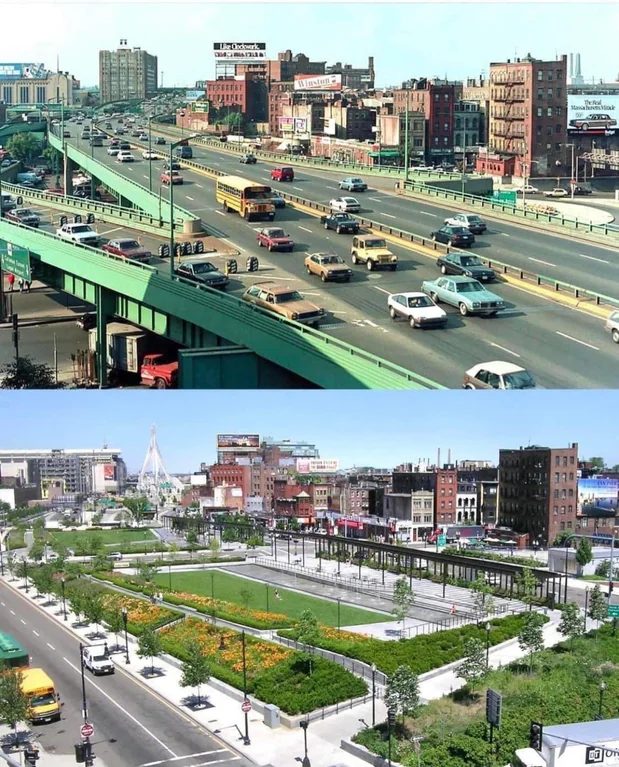The Big Dig
Is it considered a success?
The Big Dig was the largest highway project in American history. It was conceived in 1987, broke ground in 1991, and wasn’t completed until 2007.
Costs rose from $2.3 billion to $14.8 billion. When the loan is paid off in 2038, the total cost will have been $24 billion.
Four workers died during the project. Traffic was so congested for years that delays were blamed for deaths in ambulances. Several people were killed from otherwise-survivable accidents inside the tunnels because the original guardrails had a tendency to decapitate people (they were dubbed the “ginsu guardrails”). In 2006, ceiling panels started to fall down due to defective glue. One woman was killed when her car was crushed.
So, was it all worth it?
As with many things, it depends who you ask.
In an article entitled “The Big Dig: Was it worth it?” a Boston news channel asked some Bostonians. Results were mixed.
Despite the billions of dollars spent to depress the Central Artery, the region’s traffic woes seem worse than ever.
One woman said she thinks it is still bad and that the new roadway encouraged people to drive instead of taking the T. Another man said he thought it had not helped move traffic along any better.
In a 2015 article entitled “10 years later, did the Big Dig deliver?”, the Boston Globe feels like it worked:
How are we feeling now? Maybe there’s room for some grudging appreciation.
Rush hour brings what radio reporters refer to as heavy volume. But the traffic moves, and for 1.5 miles through downtown Boston, it moves out of sight, underground. Above those famously expensive tunnel boxes is some of the most beautiful and valuable urban real estate anywhere in the nation, if not the world. Getting to and from Logan Airport has never been easier, whether picking up grandma or getting an executive to a startup in Fort Point or along Route 128.
The article noted that the prior system was carrying 200,000 cars per day before the Big Dig, and it now it carries 536,000 cars per day. This, of course, might just be induced consumption, which means even though more cars are traveling, traffic isn’t actually better because more people drive now.
The article notes that there’s more than one way to measure success. The destruction of the prior road system – called “The Central Artery” – opened up large areas of land in downtown Boston, which is a benefit and success not measured by traffic congestion.
In a 2015 article entitled “Can We Talk Rationally About the Big Dig Yet?”, Boston.com quoted Timothy Love, the president of the Boston Society of Architects:
From my perspective, were the complications worth the result? Absolutely. Ten-fold. The relative ease of driving my car from South Boston to Everett, and the way it’s transformed my everyday life downtown where I run a business – I’m not sure why it wasn’t worth it but that’s a personal opinion.
So, there’s no clear agreement.
Evaluating any “success” here is based on time horizon. How long will it take to be replaced? How long can we benefit from the expense. If it lasts 10 years, then it’s a failure. If it lasts 100, then it’s a success.
The pain will fade with time, but the benefits will remain. Thus, there will be a certain point in the future when public opinion will probably coalesce on the side of it being worth the trouble.
Why I Looked It Up
I don’t remember. I’ve always wondered, because I follow the Big Dig project closely. The first time I was in Boston, in fact, I asked the driver to take me through the Big Dig from the airport. I think he responded, “That’s the only way to get downtown.”
It suddenly came up for some reason, which got me thinking about it.
Update
Although The Big Dig is not mentioned specifically, a NY Times article entitled Years of Delays, Billions in Overruns: The Dismal History of Big Infrastructure discusses why these projects overrun their budgets so much and with such expectation and regularity.
Here’s the optimistic version:
“All the major projects have cost and schedule issues,” he acknowledged. “The truth is these are very high-risk and difficult projects. Conditions change. It is impossible to estimate it accurately. That is naïve.”
And here is the very cynical version, taken from a 2013 column by former San Francisco mayor Willie Brown:
In the world of civic projects, the first budget is really just a down payment. If people knew the real cost from the start, nothing would ever be approved.
The idea is to get going. Start digging a hole and make it so big, there’s no alternative to coming up with the money to fill it in.
Update
date: 2024-04-24 I found this picture somewhere on the web, showing the difference between the Central Artery from the 80s and the current greenway that exists where it used to be.
